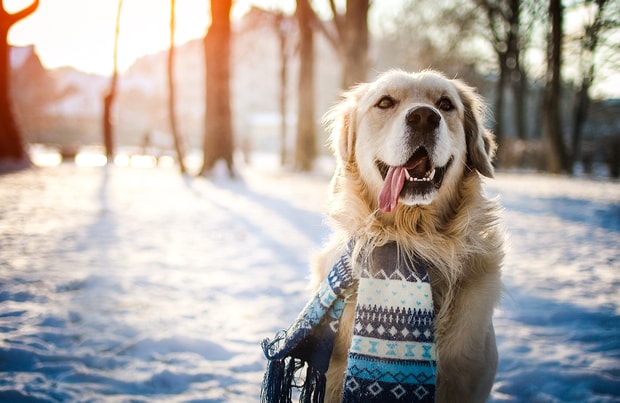You’re probably aware of the risks of antifreeze and how rock salt can hurt your dog’s sensitive paws. But few pet owners know that the risk of parasites is still very much alive in winter. Or that cold weather, rain, and snow can actually be quite dangerous to dogs if you don’t take the necessary precautions.
Here are four common misconceptions you need to be aware of as the temperature starts to drop.
Myth 1: Flea and Tick Protection Isn’t Needed in Winter
Think your pets are safe from fleas and ticks just because it’s winter? Not necessarily, according to Chelsea Sykes, DVM, from the SPCA Tampa Bay Veterinary Center.
“Winter months in the colder parts of the country can be a respite from fleas and ticks, but it must freeze for three to four weeks at a minimum to really see any benefit,” she says. “But there are many other states that do not fit in this group.”
Unless you live in an area with very serious winter weather, Sykes recommends continuing your normal monthly heartworm, flea, and tick regimen year round. “This is the only way to ensure pets are always covered,” Sykes adds.
Myth 2: Dogs Don’t Need Sweaters Because They Have Their Own “Fur Coats”
Arctic breeds such as Huskies and Malamutes have a thick coat and undercoat designed to keep them warmer in the winter months. So if you own a “winter breed,” chances are you don’t need to worry about jacket shopping for Fido. “However, most of the short haired breeds – including Greyhounds, Chihuahuas, Jack Russell terriers, and many others – will get very cold in the winter and would benefit from both a sweater and booties,” Sykes says. “Booties are often forgotten but paw pads can get so cold from walking on ice and in very cold snow that the animals can suffer from frostbite.”
Even breeds with longer hair can benefit from some kind of protection to keep the snow from clinging to the hair. “Lack of dog sweaters or coats really just puts unnecessary stress on the animal and can increase the risk of hypothermia in the ears and tail,” Sykes explains. “Their bodies have to work harder to keep them warm, which makes them more prone to infections and can predispose them to other ailments that are brought on by stress.”
Myth 3: You Only Have to Worry About Dehydration in Summer
Most people associate dehydration with hot days, but the truth is that dogs can get dehydrated at any time, including winter. “Winter dehydration is just as dangerous as summer dehydration and looks very similar, with common signs being sleeping more, lethargy, tenting of the skin, sticky gums, sunken eyes, and vomiting,” Sykes says. “The biggest danger is that few people consider it, or they forget it is a very real threat.”
According to Sykes, this myth persists because when the weather is cold, the ways in which we lose water are not as obvious as sweating. “Daily life actually requires a ton of water, mostly because our bodies regular homeostasis mechanisms require water just to keep everyone at their preferred internal temperature,” explains Sykes. During winter, these water requirements actually increase because of colder external temperatures combined with lower humidity (so there is more water lost due to evaporation).
On top of that, Sykes points out that both humans and pets often don’t drink as much in winter because it is colder out. “Indoors, the higher heat settings on the thermostat also lower the humidity in the house or car which creates an arid or desert like environment and results in more evaporation from our bodies,” Sykes says.
Myth 4: I Don’t Need to Dry Off My Dog After a Walk in the Snow
If a winter walk outside is in the cards for you and your dog, make sure to dry them off as soon as you come indoors. “When a dog or cat gets wet, either from rain or snow, and is drenched thoroughly, regardless of hair type, you should thoroughly dry them to prevent hypothermia,” says Sykes.
Why is this? Simply put, wet hair affects the undercoat’s ability to preserve heat. “Water right on the skin takes heat from the body to warm up and evaporate off, which then cools the dog or cat further, so they actually get colder as they dry naturally,” explains Sykes. By drying off your dog instead, you take the water away from the skin and fluff up the coat, helping to ensure that your pet stays warm.
To avoid these issues, Sykes recommends buying outerwear, such as a rain jacket or water/snow proof jacket and booties. “If caught in a cold downpour, a warm (not hot) bath can help warm up [a pet’s] core temperature before drying them well,” Sykes adds. “Snow and ice that can gather in the hair between their toes can be easily removed with a warm footbath or soak.”
Diana Bocco is a full-time writer and adventurer, whose work has been published in DiscoveryChannel.com, Yahoo!, & Popular Mechanics.
Share:









